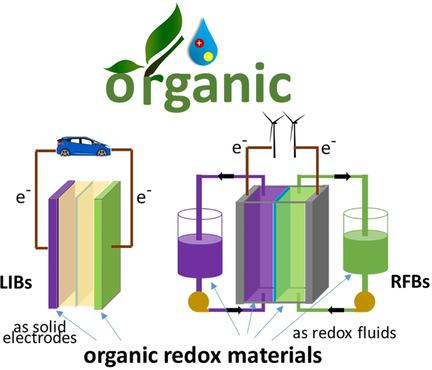当前位置:
X-MOL 学术
›
ChemSusChem
›
论文详情
Our official English website, www.x-mol.net, welcomes your
feedback! (Note: you will need to create a separate account there.)
A Comparative Review of Electrolytes for Organic-Material-Based Energy-Storage Devices Employing Solid Electrodes and Redox Fluids.
ChemSusChem ( IF 7.5 ) Pub Date : 2020-03-20 , DOI: 10.1002/cssc.201903382 Ruiyong Chen 1 , Dominic Bresser 2, 3 , Mohit Saraf 2, 3 , Patrick Gerlach 4 , Andrea Balducci 4 , Simon Kunz 5, 6 , Daniel Schröder 5, 6 , Stefano Passerini 2, 3 , Jun Chen 7
ChemSusChem ( IF 7.5 ) Pub Date : 2020-03-20 , DOI: 10.1002/cssc.201903382 Ruiyong Chen 1 , Dominic Bresser 2, 3 , Mohit Saraf 2, 3 , Patrick Gerlach 4 , Andrea Balducci 4 , Simon Kunz 5, 6 , Daniel Schröder 5, 6 , Stefano Passerini 2, 3 , Jun Chen 7
Affiliation

|
Electrolyte chemistry is critical for any energy-storage device. Low-cost and sustainable rechargeable batteries based on organic redox-active materials are of great interest to tackle resource and performance limitations of current batteries with metal-based active materials. Organic active materials can be used not only as solid electrodes in the classic lithium-ion battery (LIB) setup, but also as redox fluids in redox-flow batteries (RFBs). Accordingly, they have suitability for mobile and stationary applications, respectively. Herein, different types of electrolytes, recent advances for designing better performing electrolytes, and remaining scientific challenges are discussed and summarized. Due to different configurations and requirements between LIBs and RFBs, the similarities and differences for choosing suitable electrolytes are discussed. Both general and specific strategies for promoting the utilization of organic active materials are covered.
中文翻译:

使用固体电极和氧化还原液的有机材料储能装置电解质的比较综述。
电解质化学对于任何储能设备都至关重要。基于有机氧化还原活性材料的低成本且可持续的可再充电电池对于解决当前具有金属基活性材料的电池的资源和性能限制具有极大的兴趣。有机活性材料不仅可以用作传统锂离子电池(LIB)装置中的固体电极,还可以用作氧化还原液流电池(RFB)中的氧化还原液。因此,它们分别适合于移动和固定应用。本文讨论并总结了不同类型的电解质,设计性能更好的电解质的最新进展以及尚待解决的科学挑战。由于LIB和RFB之间的配置和要求不同,讨论了选择合适电解质的异同。涵盖了促进有机活性材料利用的一般和特殊策略。
更新日期:2020-03-20
中文翻译:

使用固体电极和氧化还原液的有机材料储能装置电解质的比较综述。
电解质化学对于任何储能设备都至关重要。基于有机氧化还原活性材料的低成本且可持续的可再充电电池对于解决当前具有金属基活性材料的电池的资源和性能限制具有极大的兴趣。有机活性材料不仅可以用作传统锂离子电池(LIB)装置中的固体电极,还可以用作氧化还原液流电池(RFB)中的氧化还原液。因此,它们分别适合于移动和固定应用。本文讨论并总结了不同类型的电解质,设计性能更好的电解质的最新进展以及尚待解决的科学挑战。由于LIB和RFB之间的配置和要求不同,讨论了选择合适电解质的异同。涵盖了促进有机活性材料利用的一般和特殊策略。











































 京公网安备 11010802027423号
京公网安备 11010802027423号